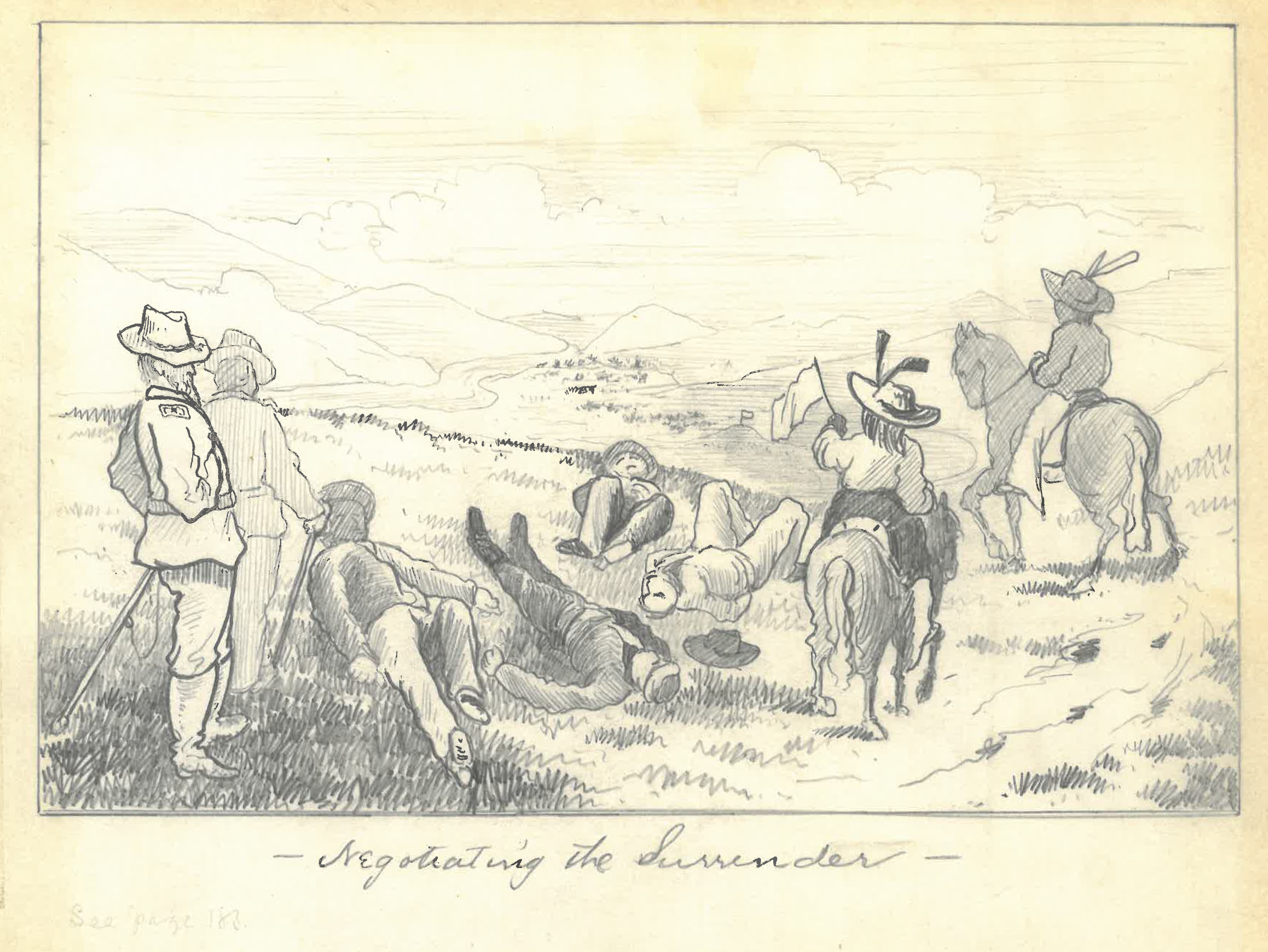- Catalog No. —
- Grace Howard Gray scrapbook, Mss 6049, Folder 13
- Date —
- 1877
- Era —
- 1846-1880 (Treaties, Civil War, and Immigration)
- Themes —
- Environment and Natural Resources, Government, Law, and Politics, Native Americans, Oregon Trail and Resettlement
- Credits —
- Oregon Historical Society
- Regions —
- Central Northeast
- Author —
- Guy Howard
Negotiating the Surrender
This sketch by Guy Howard depicts a scene from the surrender of Nez Perce Indians (Nimi’ipuu) to the U.S. Army in early October 1877. Guy Howard was the son and aide-de-camp of General Oliver Otis Howard, commander of one of the military units that pursued the Nez Perce during the Nez Perce War of 1877.
After mounting a four-month defensive retreat from eastern Oregon and north-central Idaho, the non-treaty Nez Perce bands led by White Bird, Looking Glass, and Chief Joseph came under siege by the U.S. Army at a site in the Bear Paw Mountains, forty miles south of the U.S.-Canadian border (present-day Montana). Beginning on September 30, 1877, companies of the Seventh Cavalry, led by Colonel Nelson Miles, made several attacks on the Nez Perce camp, located in the ravines and coulees of a Snake Creek stream bed. Over the course of the next several days, the conflict reached a stand-off. The cavalry was unable to successfully dislodge the Nez Perce, while the Natives found themselves in an increasingly perilous situation. Numbering over six hundred, they were without horses or shelter, their food supplies slowly diminishing. With the onset of winter, the elderly, women, children, and wounded were especially vulnerable. At this point, the Nez Perce debated the possibility of making a break through the army’s lines. This option seemed unlikely since the healthy warriors were unwilling to leave their families behind.
Early in the siege, the Nez Perce hoped that the Lakota with Sitting Bull’s camp in Canada might come to their rescue. When no assistance came, Chief Joseph decided to enter negotiations with Colonel Miles. On October 4, 1877, General Howard arrived accompanied by two aides, three interpreters, and a detachment of seventeen men, the main body of his army still en route. This sketch by Guy Howard likely shows Captain John and Old George, the two treaty Nez Perce who accompanied Howard and helped complete negotiations with the non-treaty Nez Perce. On October 5, General Howard sent a message with the two emissaries, indicating that additional troops were en route and that if the Nez Perce surrendered, they would be properly treated as prisoners and would be given food and blankets. Earlier, Colonel Miles had indicated that they would be allowed to winter in Montana and then be taken to the Nez Perce Reservation in Idaho. There was disagreement in the Nez Perce camp, as White Bird and Looking Glass did not trust General Howard. In the end, Chief Joseph agreed to end hostilities, believing that his people might return to the Northwest with honor. While Looking Glass became the last casuality of the battle, White Bird and his band did make a successful bid to reach Canada.
Although Colonel Miles believed Chief Joseph and his group would be allowed to settle on the Nez Perce Reservation, senior military officials decided to exile them to Indian Territory (Oklahoma and Kansas), and this decision was approved by the War and Interior departments. In 1885, Chief Joseph’s group was sent to the Colville Reservation in northern Washington, several hundred miles away from their ancestral homelands in the Wallowa region of eastern Oregon. The surviving members of the bands led by Looking Glass and White Bird were permitted to settle on the Nez Perce Reservation upon their return from Canada.
Further Reading:
Walker, Deward, E. “Nez Perce.” In Handbook of North American Indians. Vol. 12. Plateau. Deward E. Walker, ed. Washington D.C., 1998: 420–438.
Haines, Francis. The Nez Percés: Tribesmen of the Columbia Plateau. Norman, Okla., 1955.
Utley, Robert M. The Indian Frontier of the American West, 1846-1890. Albuquerque, N.M., 1984.
Carpenter, John. Sword and Olive Branch: Oliver Otis Howard. New York, N.Y., 1999.
Written by Melinda Jette, © Oregon Historical Society 2003.
